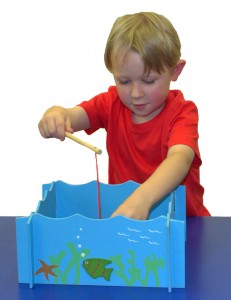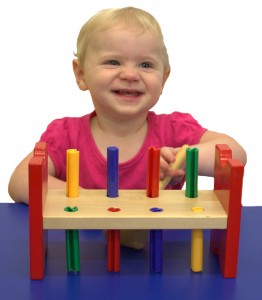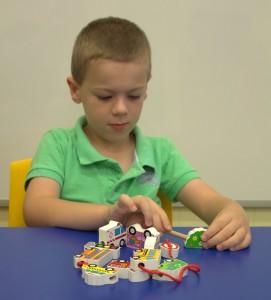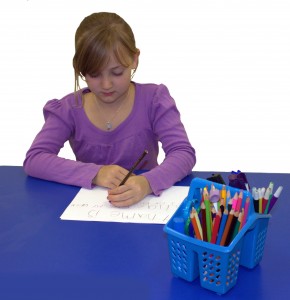
Eye hand coordination is also called visual motor integration. It involves using visual information from the eyes to guide the movements of the hands. These skills are important for daily activities such as using buttons and shoelaces, school activities such as drawing, writing, cutting and colouring, sporting activities especially ball sports and play activities such as puzzles, construction and craft activities. Children who have difficulty developing visual motor skills can find it hard to do many tasks.
Difficulties with visual motor skills may show in preschool with difficulty with tasks such as puzzles, drawing and using scissors or at school with difficulties with hand writing. Often the problems are not related to eye sight, with normal visual acuity or with movements of the muscles with normal strength and range of movement. Visual motor difficulties are about the way the brain coordinates information from the eyes and the muscles of the hands and makes the two work together.
If you are concerned about your child's eye hand coordination an assessment with an occupational therapist can provide information about your child's skills and how to improve them.
Here is a guide to the development of visual motor skills
Babies can:
- follow a rattle with their eyes moving from the middle to the side and back to the middle by three months
- place their hand flat on the table from three months
- by six months reach for a rattle with a straight arm when lying on their back
- watche their own hands moving and touch their fingers together by six months
- brings their hands together around a block when sitting by nine months
- reach for rattle with one arm while lying on their back and holding the other arm still by nine months
- pick up one small block, move it to the other hand and pick up a second block then hold both by nine months
- bang a cup on the table and poke fingers into holes in toys by nine months

One year olds can:
- put a small block in adults hand or in a cup
- pull pegs from a pegboard
- pull off both socks
- pick up small items with one finger and thumb and drop it into a cup
- pull on a string to get an attached toy
18 month olds can:
- put a few pegs in a pegboard
- stir a spoon in a cup
- tip small items out of a bottle
- stack two or three blocks
Two year olds can:
- place shapes in a simple form board
- stack four to six blocks
Three year olds can:
- build a bridge with three blocks
- stack seven or eight blocks
- build a wall with four blocks
- thread a few beads on a string
Three and a half year olds can:
- cut paper into two
- put small items into a bottle
Four year olds can:
- copy crosses, squares, and diagonal lines

At 5 to 6 years a child can:
- copy a square and triangle
- use a tripod grasp with thumb and finger for pencils
- button and unbutton a single button
- cut along a line
- stack many small blocks
- colour inside the lines
- write their first name
- be consistently left or right handed
Providing your child with lots of practice with activities that help them use their eyes and hands together can help develop a child's eye hand coordination. Here are some activities your child may enjoy:
- for younger children try stacking cups, stacking rings, shape sorters and form boards
- for preschoolers provide an range of drawing opportunities and materials such as crayons, textas, pencils, blackboards, whiteboards, highlighters, paint and chalk. You can use chalk or a paintbrush and plain water outside on a wall or concrete.
- play games that involve manipulating small pieces such as chinese checkers, connect four, ludo
- provide craft activities such as collage with pop sticks, toothpicks, pom poms, stickers, paper shapes and foam pieces
- provide activity books such as dot to dots, mazes, finish the drawing, tracing and colouring.
- try lacing cards, threading beads, macaroni, cut up straws, fruit loops and paper shapes with holes punched in them.
- try magna-doodles, etch-a-sketches and drawing apps on a tablet
- try pegboards and cork boards with hammering shapes
- try dress ups and dressing dolls with different fastenings
- try construction toys such as blocks, lego, meccano
- try ball games such as bouncing and throwing at targets or into containers
- try bean bag and balloon games
- try games with bats, start with hittting a balloon them move to a larger then smaller ball
 Supporting children with eye hand coordination difficulties. Children with these difficulties can find many tasks frustrating and they may try to avoid doing them. This lack of practice can make things worse. Children who struggle with hand writing may avoid written tasks and this can impact on their literacy development. Supporting children to be successful means that they will feel confident to practice these tasks and this will in turn develop their skills. Here are some ways children can be supported at home, preschool and school.
Supporting children with eye hand coordination difficulties. Children with these difficulties can find many tasks frustrating and they may try to avoid doing them. This lack of practice can make things worse. Children who struggle with hand writing may avoid written tasks and this can impact on their literacy development. Supporting children to be successful means that they will feel confident to practice these tasks and this will in turn develop their skills. Here are some ways children can be supported at home, preschool and school.
- To help colouring within the lines you can glue wool or string around the boundaries to help the child keep inside the lines. You can also ask them to trace around the lines with a crayon before colouring inside the lines.
- Threading is easier if it is done on a pipe cleaner or thick plastic cord rather than string.
- Hand over hand help to learn the movement sequence for making letters can help.
- Larger pencils and brushes are easier to use than smaller ones.
- Allow the child alternatives to writing for some tasks such as typing, a scribe or using an iPad.
- An occupational therapist may be able to recommend modifications to tasks and supportive equipment to help children with tasks that they find challenging.
Children with special needs sometimes need individualised support based on an assessment of their abilities and challenges. If you need support helping your child to develop eye hand coordination an appointment with an occupational therapist can be invaluable.
Talking Matters provides speech pathology and occupational therapy services to children of all ages. To find out more about our speech pathology services click here. To find out more about occupational therapy click here.
To find out more about Talking Matters visit us on our website, Facebook page, Twitter, or Pinterest.
Good luck with developing these important skills!
Related Blog Posts
If you liked this post you may also like:
Making Christmas fun
Struggling at school?
Talking diagnosis
Using POP THE PIG To Grow



